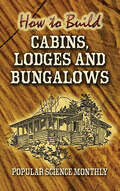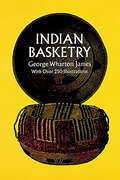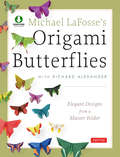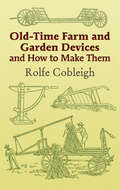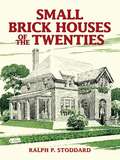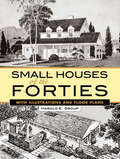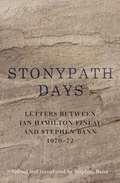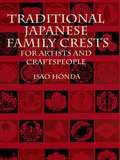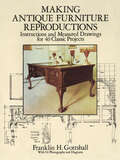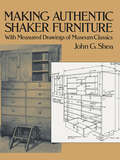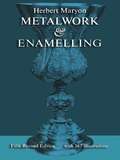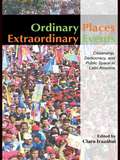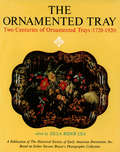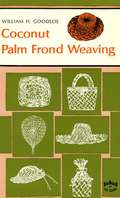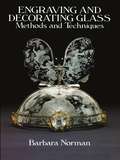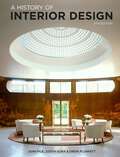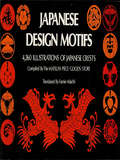- Table View
- List View
How to Build Cabins, Lodges and Bungalows
by Popular Science Monthly"Nothing could be more American than the simple cabin. Not many generations ago, it was the backbone of American life, the headquarters of that important unit, the home. It provided shelter, protection, and a foundation upon which to build a great empire. The pioneer cabin was, in other words, a necessity." -- From the IntroductionOnce regarded as a safe haven and a vital source of security, the little cabin in the country is today more closely associated with leisurely activities -- a vacation spot and even a health investment. First published in the 1930s, this helpful guide was designed to provide vacation home builders with all the information they needed to construct, decorate, and furnish a rustic little cottage. Floor plans and outlines of necessary materials are included, as are tips on constructing foundations, porches, doors, windows, fireplaces, and other structural elements. There are even suggestions for furnishing and beautifying your cabin.A useful how-to manual, offering straightforward advice on the building process from foundation to roof, this practical book can also be enjoyed as an entertaining look at lifestyle elements of the early twentieth century.
How to Grow Orchids
by Jack KramerHow to Grow Orchids presents the variety in the orchid family and discusses proper care and technique for cultivating orchids both inside and out.
Indian Basketry
by George W. JamesSince it first publication in 1901, this pioneering study by George Wharton James, once a leading collector and authority, has become a valuable source book for American Indian basketry. From Poma mush baskets to Paiute dicing trays, Indian Basketry traces the origin, development, and fundamental principles of Indian basket designs for the major tribal units in Southwestern United States and Pacific Coast, with occasional comments on the basket weaving of a number of other North American tribes.Author of several books on the Southwest, George James has used his extensive experience in the field to compile indispensable information (much gathered directly through interviews with Indian basketmakers) covering nearly every aspect of Indian basketry: esthetics, designs, dyes, and coloration, weaving and stitching techniques (including the bamtush and dah-lah methods), basket types, tribal variation, and functional considerations, offering clear instructions for those who may be interested in reproducing these ancient American crafts. James also includes a description of various native weaving materials such as pine root, bark, sumac, willow, twigs, fern stalks, grass and palm fronds, with suggestions regarding the ways in which the Indians wove shells, feathers, beads, leather, and pine needles into their basket designs.The book is a valuable aid for the artist, designer, and craftsman, or even for the beginner, who may wish to re-create authentic and often extinct basket forms and decorative motifs. It is also most useful to the collector, cultural historians, ethnologist, scholar, or buff, who desires to know more about specific aspects of Indian basketry, or about Indian arts in general. As an important contribution to the historiography of American Indian culture, this may be one of the most practical Indian basketry books that you could own.
Michael LaFosse's Origami Butterflies
by Michael G. Lafosse Richard L. AlexanderWhimsical, exquisite and fragile, butterflies and moths have enchanted and inspired people for centuries. Origami artist Michael G. LaFosse is no exception. His original butterfly paper-folding techniques are a dramatic new development in origami-which some have hailed as the most important advance in origami since the first paper cranes appeared centuries ago. Hundreds of LaFosse butterflies have been featured in exhibitions around the world and his iconic designs are now eagerly sought and widely imitated by folding enthusiasts everywhere.Michael LaFosse's Origami Butterflies presents 26 original projects from LaFosse's extensive butterfly and moth repertoire, including all his personal favorites. This collection has many rarely-seen designs, and several of the models illustrate new technical and design achievements made possible by the ingenious "LaFosse Origami Butterfly Folding System."These elegant forms-each created from a single square sheet of paper without cutting or glue-showcase the versatility of the folding system. All are deceptively simple, yet provide a solid foundation for creative flights of fancy in the hands of an experienced folder. Clear step-by-step instructions show you how to make literally hundreds of different variations by making small adjustments to a few key folds! Whether dry-folded from recycled candy wrappers or wet-folded from expensive handmade papers, these designs exemplify the best aspects of the paper folder's art today.This exciting new book with accompanying DVD represents the culmination of a lifetime of designing and perfecting the art of origami butterflies. It contains everything you need to create your own unique collection!Butterflies include:A Butterfly for Vanessa GouldThe Butterfly for Robert LangA Butterfly for Eric JoiselA Swallowtail for Guy KawasakiThe Boston ButterflyThe Mudarri Luna Moth
Old-Time Farm and Garden Devices and How to Make Them
by Rolfe CobleighA splendid bit of rural Americana, Cobleigh's book shows how anyone with a little time and money can add a touch of authentic charm to their farm, house, or garden. First published nearly a century ago, this practical guide features dozens of projects, accompanied by some 200 illustrations. A simply written text not only tells how to mount an anvil, make a cheese press, and build hog houses, but also provides handy advice on splitting wood, testing seed corn, tying practical knots, sharpening scissors, and papering a room.From building a rose trellis to creating a bicycle-powered washing machine, readers will delight in this book’s abundance of enjoyable and useful projects. It’s perfect for novice craftworkers and die-hard fans of Yankee ingenuity.
Organic Gardening without Poisons
by Hamilton TylerThis book explains how to restore health to the home garden by returning to natural gardening methods. Nature can benefit the gardener if he does not interfere with its complicated and delicate balance by using synthetic insecticides and fertilizers.
Small Brick Houses of the Twenties
by Ralph P. StoddardOnce affordable only among the wealthy, brick homes became more easily available to the average American in the early years of the twentieth century. This book, originally published in 1920 by a member of The Common Brick Manufacturers' Association, served as a practical guide for prospective homeowners from working class families. Many soon found that attractive, durable, and comfortable homes--made from nature's own building material--were easily within their financial reach. <p><p> Thirty-five sets of floor plans, elevations, and specifications in this excellent reproduction of that now-rare volume depict a wide variety of brick houses, bungalows, cottages, garages, and multi-dwelling buildings--from the four-bedroom Pocatello to the handsome Saratoga, featuring a wraparound porch and two bathrooms. This practical guide will appeal to anyone wanting to buy or renovate an existing home of the period. It will also serve as a how-to manual for all desiring to build their own homes today with authentic materials and techniques. For those who love fine, old buildings, Small Brick Houses of the Twenties offers a charming view of American homes from that era.
Small Houses of the Forties: With Illustrations and Floor Plans
by Harold E. GroupDesigned for the 1940s family with a "limited budget but unlimited good taste," this fascinating volume presents 56 floor plans and elevations of lovely small homes that originally cost less than $15,000 to build. Each home, bearing the honorable designation of House-of-the-Month by the era's Monthly Small House Club, Inc., was designed to give prospective homeowners an exceptionally well-planned house that was also a sound investment. From Cape Cods to Colonials, Small Houses of the Forties offers an eden of illustrations of cozy, charming domiciles, complete with color combinations, charts, and diagrams. This complete republication of a now-rare volume is also filled with vintage dollars-and-sense information for the postwar homebuyer, including mortgage guidance, amortization schedules, valuations, and construction costs of the times. <p><p> A nostalgic flashback to a simpler American dream of white picket fences, this entertaining and valuable reference will delight architecture enthusiasts, plan collectors, restorers, and historians alike.
Stonypath Days: Letters between Ian Hamilton Finlay and Stephen Bann 1970-72
by Stephen Bann Ian Hamilton FinlayThese letters to (and from) Finlay's friend, the English poet and scholar, Stephen Bann, centre on the initial development of the garden at Stonypath, near Edinburgh, later to become the world renowned 'Little Sparta'. They cover Finlay's turn away from poetry towards sculpture and garden design, and the thinking behind, and consequences of, this development.
Traditional Japanese Family Crests: for Artists and Craftspeople
by Isao HondaOver 1,700 compact, graceful designs -- a traditional part of many Japanese family histories -- are featured in this handsome, versatile collection. Depicting plant, leaf, animal, and fan designs in circular motifs; astronomical images, and more, the authentic, royalty-free crests are ideal for use as spot illustrations in a variety of graphic projects.
Making Antique Furniture Reproductions: Instructions and Measured Drawings for 40 Classic Projects
by Franklin H. GottshallWith this profusely illustrated guide, even beginning woodworkers can build precise reproductions of the most sought-after antique furniture -- heirloom pieces by Sheraton, Hepplewhite, Duncan, Phyfe, Chippendale, and other celebrated craftsmen. It's possible by following the simple, step-by-step procedures outlined in this expert manual.You'll learn how to construct such magnificent antiques as a Chippendale flat-topped partner's desk, Queen Anne handkerchief table, Sheraton drop-leaf dining table, Hepplewhite four-poster bed, grandfather clock, Queen Anne spice cabinet, and many more. Every step is clearly explained and illustrated, with remarkably detailed and precise construction drawings, accompanied by exact measurements. You'll even find superb photographs of the finished pieces.The book begins with an expert introduction to the fundamentals of cabinetmaking and woodworking: how to cut, square, and plane lumber; the use and care of hand tools; and then clear explanations of such processes as joinery, drawer construction, dovetailing, wood turning, gluing, bull and claw foot carving, and other wood carving details as well as how to choose the correct stock. Also included is a wealth of time-tested advice on selecting hardware, finishing, and other aspects of the craft.No matter what your level of woodworking expertise -- novice to expert -- the exceptionally precise and well-thought-out instructions and diagrams in this book will enable you to craft beautiful and authentic antique furniture you'll be proud to use and display for years to come.
Making Authentic Shaker Furniture: With Measured Drawings of Museum Classics
by John G. SheaThis splendid book describes and illustrates in detail how the Shakers designed, built, and finished their furniture and household articles. With its detailed text as well as over 250 photographs and measured drawings for over 80 classic pieces, it offers woodworkers and furniture enthusiasts a practical guide to the essentials of replicating a broad range of designs long admired for their sturdy practicality and their spare, elegant beauty.The book first chronicles and describes the Shaker movement and the Shaker way of living, worshiping, and working. It then explores the Shaker approach to furniture design (from chests and chairs to boxes and baskets), construction (including all joinery techniques), and finishing (including recipes for finishes).Three important sections of the book depict dozens of classic Shaker designs, complete with measured drawings. The designs include Shaker "smallcraft" such as a cutting board, scoop, candle sconce, peg-leg footstool and towel rack; more substantial "utility designs" such as a dough bin, cradle, dry sink, butcher block, and bonnet box; and furniture classics such as a Harvard trestle table, maple chair, lap desk, sewing chest, rocking chair, bed, settee and chest of drawers -- each in its own distinctive way defining the simple, practical grace of Shaker design.
Metalwork and Enamelling
by Herbert MaryonAll those concerned with goldsmithing, silversmithing, rare metal objects, or metal scientific instruments, or their repair or restoration will be delighted to find this bible of their craft available again in a new edition. And those interested in such work as one of the most rewarding of all avocational arts can hardly find a better guide. For this is the professional's handbook -- the standard text on the subject.The author, who, among his other achievements, was responsible for reconstruction work on the Sutton Hoo treasure in the British Museum (and was awarded the Order of the British Empire for his work), treats every aspect of the craft in detail, from basic tools to casting and enameling in separate sections. After discussing materials and tools, he provides a treatment of soldering in rare metals that is more extensive, more thorough, and richer in practical advice than can be found elsewhere. He continues into filigree work, the setting of stones, raising and shaping, spinning, repoussé work, wire twisting, hinges and joints, inlaying and overlaying, niello, alloys and stratified fabrics, enameling (including cloisonné, plique-à-jour, champlevé, bassetaille, encrusted and painted enamels), metal casting, construction, setting out, polishing and coloring, design, and assaying and hallmarking. Wherever possible, he analyzes examples of fine craftsmanship, ancient and modern, to illustrate practical aspects of the process he is explaining. Helpful hints are included on shop set-up and safety. The vastness of the author's experience in the actual work, with his authoritative knowledge of the entire field, ensures that readers of Metalwork and Enamelling are being advised and guided by a renowned expert.Over 300 figures and photographs amplify the discussion of tools, materials, and construction. Tables and standards useful to the craftsman (melting points and weights of metals, for example) are included. Notes to the photographic plates describe the objects in detail -- magnificent examples of craftsmanship throughout the ages. Both complete and concise, this book belongs close to every rare metals workshop, laboratory, museum shop, and craft center.
Ordinary Places/Extraordinary Events: Citizenship, Democracy and Public Space in Latin America (Planning, History and Environment Series)
by Clara IrazábalClara Irazábal and her contributors explore the urban history of some of Latin America’s great cities through studies of their public spaces and what has taken place there. The avenues and plazas of Mexico City, Havana, Santo Domingo, Caracas, Bogotaì, SaÞo Paulo, Lima, Santiago, and Buenos Aires have been the backdrop for extraordinary, history-making events. While some argue that public spaces are a prerequisite for the expression, representation and reinforcement of democracy, they can equally be used in the pursuit of totalitarianism. Indeed, public spaces, in both the past and present, have been the site for the contestation by ordinary people of various stances on democracy and citizenship. By exploring the use and meaning of public spaces in Latin American cities, this book sheds light on contemporary definitions of citizenship and democracy in the Americas.
The Ornamented Tray: Two Centuries of Ornamented Trays (1720-1920)
by W. D. John Zilla Rider LeaThis authoritative and definitive work contains the first formal history of antique trays every published. Each of its six chapters is written by a different authority. <P><P>They discuss:Lace-Edge PaintingThe "Chippendale" StyleTrays Ornamented with Gold LeafThe Freehand Bronze TechniquesStenciled TraysThe Country Painted TrayThe book is lavishly illustrated with more than 500 photographs, seven of them in full color, including pictures of trays prized by museums and private collectors, as well as hundreds selected from the unique photographic collection of the late Esther Stevens Brazer.
Coconut Palm Frond Weaving
by William H. Goodloe Ellen GoodloeLearn the art of palm weaving with this fun Hawaiian craft book.Based on years of meticulous study and practice, the book explains in clear, easy-to understand instructions how to obtain and prepare coconut palm fronds suitable for weaving into hats, baskets, epergnes, mats, birds, and various decorations. More than 100 easy-to-follow diagrams and sketches give the reader exact, detailed instructions on weaving procedures, and provide countless ideas to inspire the imagination of the creator. After mastering the basic principles of frond weaving, the reader will be able to duplicate almost any woven object or execute his own designs, whether in coconut palm fronds or with fronds from other types of palm trees and palmettos.The weaving itself takes no unusual physical prowess. In fact, frond weaving is well suited to the needs of both recreational craft and physical therapy programs, as well as the general hobbyist. With a little patience and effort, a novice weaver can acquire the skills of an ancient art which is as uncomplicated as it is beautiful.This economical and delightfully presented volume will be a valued addition to the literature of traditional handicrafts, a book that recreation libraries and all craft enthusiasts will welcome.
Engraving and Decorating Glass: Methods and Techniques
by Barbara NormanThe history of glass and glass decoration extends back at least to the ancient Egyptians, who made small vessels of dark glass and decorated them with glass threads of contrasting colors. Occasionally glass vessels were also engraved on the lapidary's wheel. Today, the ancient art and craft of decorating glass continues to flourish among artists and crafters attracted by its combination of artistic beauty and skilled craftsmanship. Unfortunately, until the publication of this book, there were few if any practical instruction guides for beginners in this exciting and deeply rewarding field.A well-known British artist and glass engraver, Barbara Norman has exhibited her glass widely and has won numerous awards. In this clear, profusely illustrated guide, she offers a comprehensive introduction to the history, materials, tools, and techniques of glass engraving and other forms of glass decoration.After introductory chapters on the development of glass, methods of glassmaking, decorating techniques and choosing glass, the author discusses various engraving techniques in detail: diamond point engraving, drill engraving, and copper-wheel engraving. Aspiring glasscrafters will also find excellent coverage of such interesting techniques as gold engraving under glass, painting glass, and applying glass to glass: mosaics, glass collage, glass fusing and glass forming. Most of the methods do not require a studio or workshop and call for relatively inexpensive materials.Ideal for the novice or moderately experienced glassworker, this well-written, easy-to-follow guide will enable glasscrafters to bring decorative beauty and artistic flair to glasses, tumblers, bowls, vases, plates -- almost any glass object. Beautiful engraved or decorated glass is perfect for personalized gift-giving or for adding a note of elegance to any home.
A History of Interior Design Fifth Edition
by John Pile Judith Gura Drew PileA History of Interior Design tells the story of 6,000 years of domestic and public space. It's an essential resource for students, professionals and anyone interested in interior design, the decorative arts, architecture and art history. It explores a broad range of styles and movements, weaving together a fascinating narrative from cave dwellings and temple architecture, through Gothic cathedrals and Islamic palaces, to modern skyscrapers and the retail spaces of the 21st-century.This fully updated fifth edition includes more on the contributions of women designers and architects, additional coverage of furniture, product design and decoration, as well as numerous examples of diverse modern styles from around the world. An extra final chapter focuses on the influence of the latest technology and current thinking on the importance of conservation and ethical sourcing.This new edition includes 730 images, over 300 of which are new or colour replacements for black and white photos.
Japanese Design Motifs
by Matsuya CompanyDefinitive catalogue of Japanese heraldic crests featuring almost unlimited variety of plant, animal, bird, and geometric forms -- everything from "wild goose" to "folding fan" to "mountain and mist," each with dozens of variations. 4,260 illustrations. "The 4,260 marvelous heraldic emblems...are delicate, interesting, and perfect." -- Lady's Circle Needlework.
